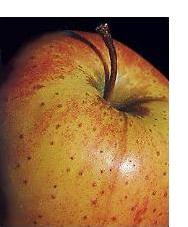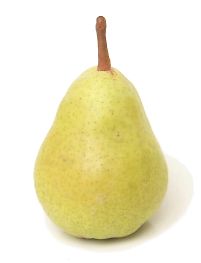 Six bud scales can be seen on this lateral bud.
Six bud scales can be seen on this lateral bud.
TWIGS
by Grandpa Cliff Oct 24, 2005
TWIG - A woody branchlet (small branch) on a tree or shrub that is connected to a larger branch. Towards the end of the growing season, a terminal bud can almost always be found at the tip of the branchlet. Most trees and shrubs can be identified by their twigs, especially in Winter after the leaves have fallen off.
BUD - on a woody stem, it is a bump that is usually covered with bud scales
 Six bud scales can be seen on this lateral bud.
Six bud scales can be seen on this lateral bud.
From a bud can grow leaves and flowers and new stem material (stem tissue). The bud at the tip of the branchlet allows it to grow longer. Buds on the side of a small branch can cause side branches to form.
There are buds at two positions on a twig.
a) Terminal Bud - at the tip of the twig. There is only one of these on a twig.
b) Lateral Bud - at the side of the twig. There can be several of these on a twig.

Both kinds of buds will make leaves and some new stem tissue. Flowers are not made in all buds.
When a bud opens up, if it is one that will produce leaves, flowers and a new stem, the beginnings of all three already exist in miniature in that bud.
When the bud scales fall off, they leave scars (little lines around the stem) to show where they were attached. Look at the five sets of Terminal Bud-Scale Scars in the drawing at the right. The can also be seen magnified in the drawing below.

HOW OLD IS A SMALL BRANCH ON A BUSH OR TREE?
When a bud opens, the thin Bud Scales that cover the bud fall off. Where a Bud Scale was fastened to the branchlet, it leaves a narrow groove. A bud scale goes only part way around the stem, so the scar (groove) for one scale goes only part way around the branchlet or twig. It takes two or three scales to go all the way around the twig. Bud-Scale Scars on twigs look like about 2-5 rows of narrow grooves around the twig (see above). The grooves are jammed together, and are usually easy to find.
The branchlet grows longer over the few months that follow the opening of the bud. Eventually a new terminal bud forms at the tip of the growing branchlet (even if the branchlet came from a lateral bud). That new bud doesn't open until the following Spring and will leave a new set of bud-scale scars. If you measure between the new bud-scale scars and last year's scars, you will know how far the branchlet grew last year. You can look back along the branch and find other sets of scars. Between any two sets of scars is one year of growth. Using this method you can tell how old the branchlet is. You can do this anytime of year including in the Winter. How old is the long twig at the right?
To determine the age of a larger branch or the trunk, you would have to count the annual rings of wood growth. For a branch, scientists could cut the branch off. To learn the age of the whole tree, scientists could cut the tree down and then view the annual rings, but that would kill the tree. Another method is to use a borer to remove a core piece of wood that is about as big around as a pencil. Then the annual rings can be counted in the core.
See How Old is That Tree? for photos of annual rings.
WHAT HAPPENS TO THE BUD-SCALE SCARS OVER THE YEARS?
The Bud-Scale Scars were formed when the branch was tiny (often skinnier than a small finger). But, a branch can get much bigger around than your arm. As the branchlet grows, the scars eventually disappear, because they can't stretch around the branch.
---------------------------------------------------------------------------------------------
LEAF SCAR - Where a leaf petiole joins a woody stem, a leaf scar will form when the leaf falls off. Leaf scars have different shapes. These differences help us decide what kind of tree a Winter twig came from. Notice the leaf scars on the diagrams above.
LENTICEL - a tiny opening
in
the bark of a branch which allows gases to get in and out of the stem. The
living inner
 bark cells can receive oxygen and get rid of their carbon dioxide
through the lenticels. A
lenticel often looks like a small dot or horizontal line on the bark.
This opening is surrounded by a small raised
growth which can often be felt by rubbing your finger along a twig.
When they are a different color from the bark they are easy to
see. Apples and pears also have lenticels. [Some branchlets have chlorophyll, although the dark color of the
bark may prevent you from seeing it. This cholorophyll can make food and
oxygen needed by the nearby cells. For photosynthesis, the branchlet needs
carbon dioxide, some of which it can get through the lenticels.]
bark cells can receive oxygen and get rid of their carbon dioxide
through the lenticels. A
lenticel often looks like a small dot or horizontal line on the bark.
This opening is surrounded by a small raised
growth which can often be felt by rubbing your finger along a twig.
When they are a different color from the bark they are easy to
see. Apples and pears also have lenticels. [Some branchlets have chlorophyll, although the dark color of the
bark may prevent you from seeing it. This cholorophyll can make food and
oxygen needed by the nearby cells. For photosynthesis, the branchlet needs
carbon dioxide, some of which it can get through the lenticels.]

Black Cherry (Prunus serotina) [S]
---------------------------------------------------------------------------------------------
Visitors since 30
Dec 2006
Go to the HOME page